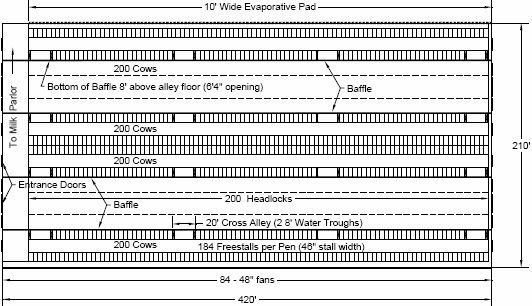



Low-Profile Cross-Ventilated Freestall Facilities
A two year study into low-profile cross-ventilated freestall facilities reinforced the belief that these facilities provide a lot of potential benefits to dairy producers, but many design challenges still remain. J. P. Harner, Ph.D. and J. F. Smith, Ph.D., Kansas State University, explain the conclusions of their study. This feature was taken from the proceedings of the High Plains Dairy Conference. A full link to the proceedings is provided below.
The MCC dairy group in South Dakota placed into operation the first LPCV wide building in fall 2005. Previously this group, and maybe others, had utilized cross ventilation in a remodeled 4-row facility prior to construction of an 8-row building. The LPCV buildings are under construction or operating currently in 7 other states and being considered in 10 additional states. Across North America, the concept of LPCV has been extended from 8- to 24- row wide buildings. Buildings with 12 and 16 rows of freestalls currently are the common choices.
Figure 1. End view of an 8-row low-profile cross-ventilated freestall building

Figure 1 shows an end view of an 8-row LPCV building. Evaporative cooling pads are placed along one side of the building and fans are placed on the opposite side. There is more space available for placement of fans and evaporative pads parallel to the ridge rather than perpendicular, because the equipment doors are located in the end walls. Figure 2 shows a layout of an 8-row LPCV building with tail-to-tail freestalls. From a top view, this design simply places two 4-row freestall buildings side-by-side and eliminates the space between the buildings for natural ventilation. One potential advantage of the LPCV or tunnel-ventilated buildings is cows are exposed to near constant wind speeds. Inside the building the air velocity or wind speed are normally less than 8 mph during peak airflow. The ventilation rate is reduced during cold weather with the wind speed reduced to less than 2 mph.
Figure 2. Top view of a typical layout of an 8-row low-profile cross-ventilated freestall building. The building length is adjustable based on cow numbers

The air quality inside the LPCV building was evaluated during 2 study periods in 2006 at the MCC dairy group’s ND facility. Particulate emissions from the 3 samplers were 78.2 ppm near the east end of the barn, 74.8 ppm in the barn’s center, and 94.8 ppm near the west barn end. These values are between 10 to 100 times less than dust concentrations from poultry and swine units (Jerez et al., 2006). By comparison, U.S. Environmental Protection Agency (USEPA, 1987) National Ambient Air Quality Standards (NAAQS) limits primary and secondary PM10 dust concentration for a 24-hr average sampling period to 150 ppm. The purpose of the primary standard was protection of public health and the secondary standard is to protect the public from known or anticipated adverse effects. The values obtained from this site are below the current standard. Dust emissions were collected in an LPCV using sand bedding. Further research is needed to investigate if dust emissions would be higher if organic bedding, such as dried manure solids or sawdust, is used.
Gas emission rates were estimated using an open-path ultraviolet (UV) spectrometer system. Gases emitted from the LPCV were found to be dominated by nitrogen-based gases (NH3, NO2, NO) during the spring and summer testing periods. Ammonia concentrations and emission rates were found to be greatest during the springtime and under the lowest ventilation rate tested (420,000 cfm; Table 1). Average concentrations of NH3 observed here (spring = 1219 ±) 5 ppb; summer = 1117 ±) 4 ppb) were lower than those reported by Zhoa et al. (2005) and Mutula et al. (2004) of 0.3 – 3.0 ppm and 36 – 51 ppm, from naturally ventilated freestall barns in Ohio and Texas, respectively.
| Table 1. Mean gaseous concentration and emissions from an 800-cow low-profile cross-ventilated dairy barn. | ||||
| Season | Ventilation Rate | NH3 (ppb) | NO2 (ppb) | NO (ppb) |
|---|---|---|---|---|
| Spring | Low | 1,370 | 445a | 8ab |
| Medium | 1,181b | 296 | 27 | |
| High | 1,108a | 417a | 0a | |
| Summer | Low | 1,084a | 176b | 0a |
| Medium | 1,157b | 145b | 4b | |
| High | 1,112a | 155b | 0a | |
| abc within a column, means without a common superscript differ (P< 0.05) using differences in Least Squares Means |
||||
Conclusions
Low-profile cross-ventilated freestall facilities are still in the early stages of understanding the optimum design and operation. It is clear that these facilities provide a lot of potential benefits to dairy producers. One of these benefits is the ability to control the cow’s environment during all seasons of the year.
The biggest challenge appears to be how to manage these structures during winter months. Low-profile cross-ventilated barns have tremendous potential; however, reasonable expectations should be considered when designing LPVC structures for a given climate. Design challenges remain as producers seek to optimize these facilities to meet their financial and cow comfort goals.
Further Reading
| - | You can view the full report by clicking here. |
View the full conference proceedings by clicking here.
August 2008



